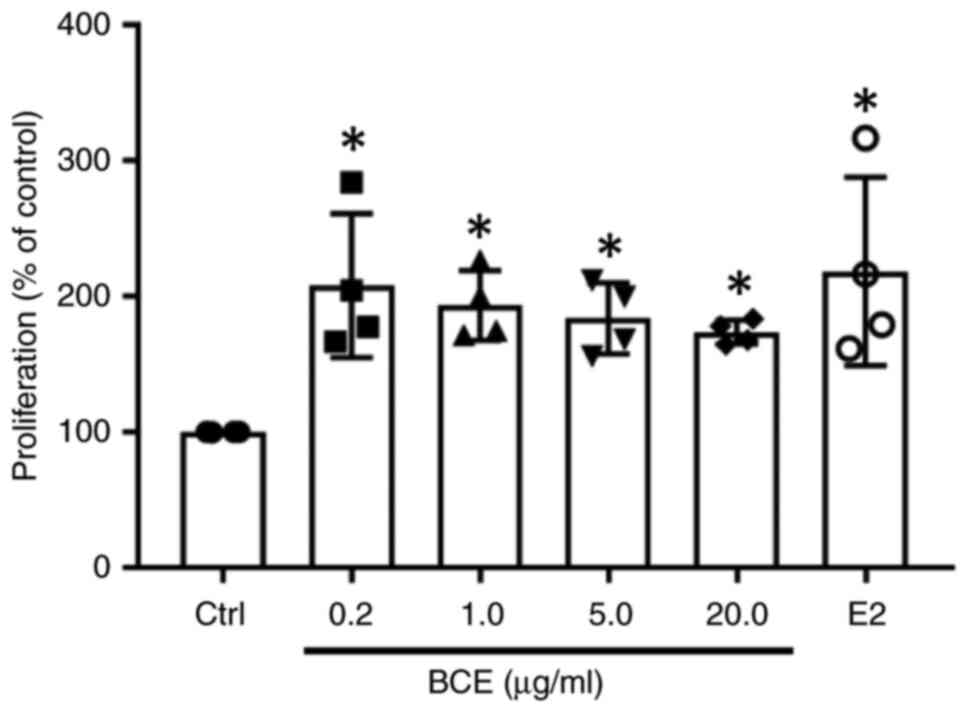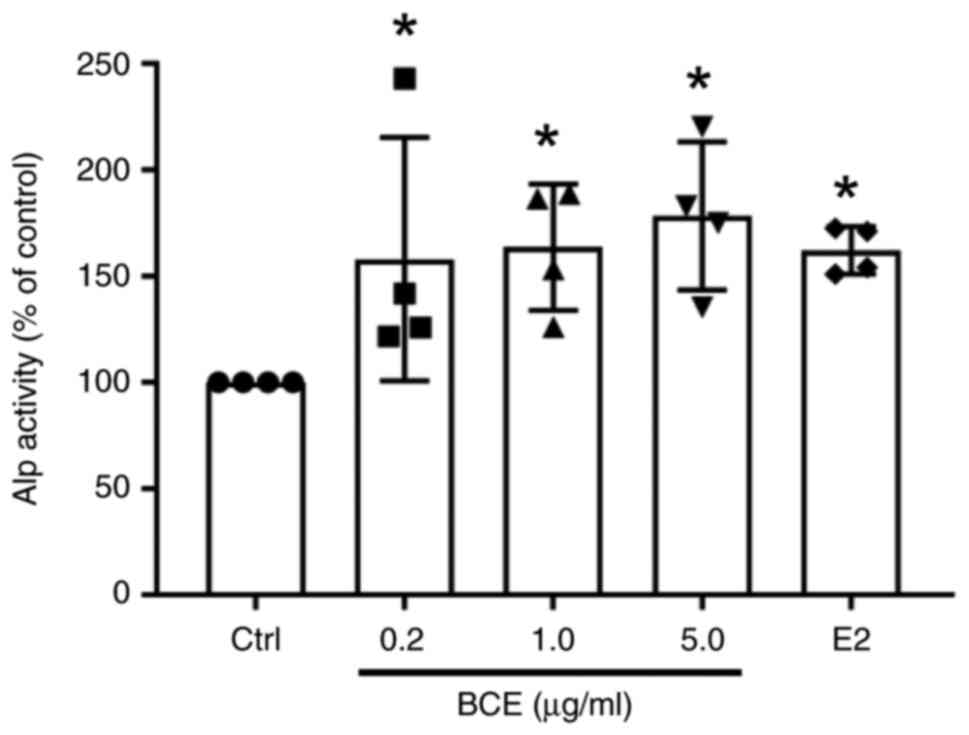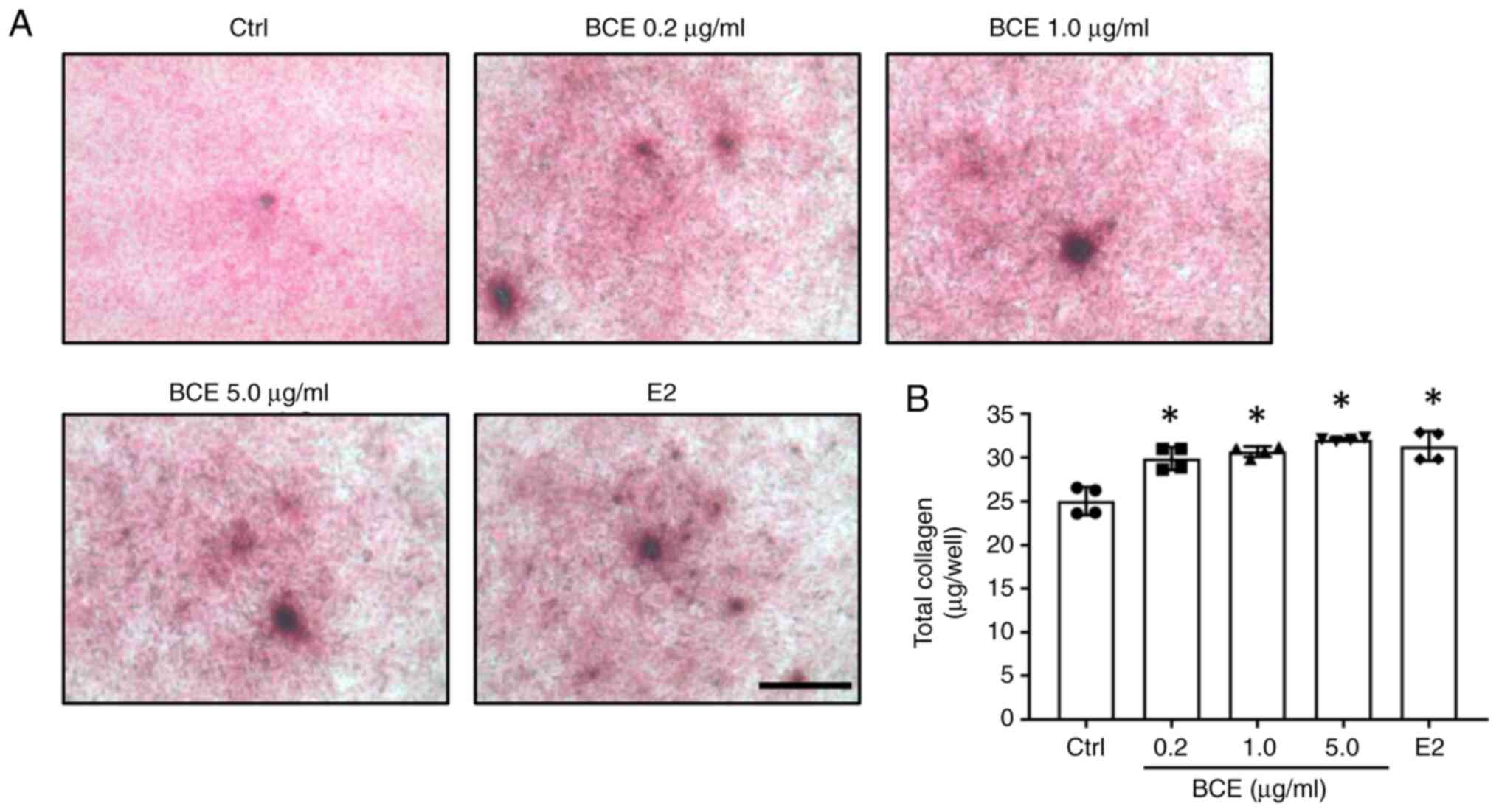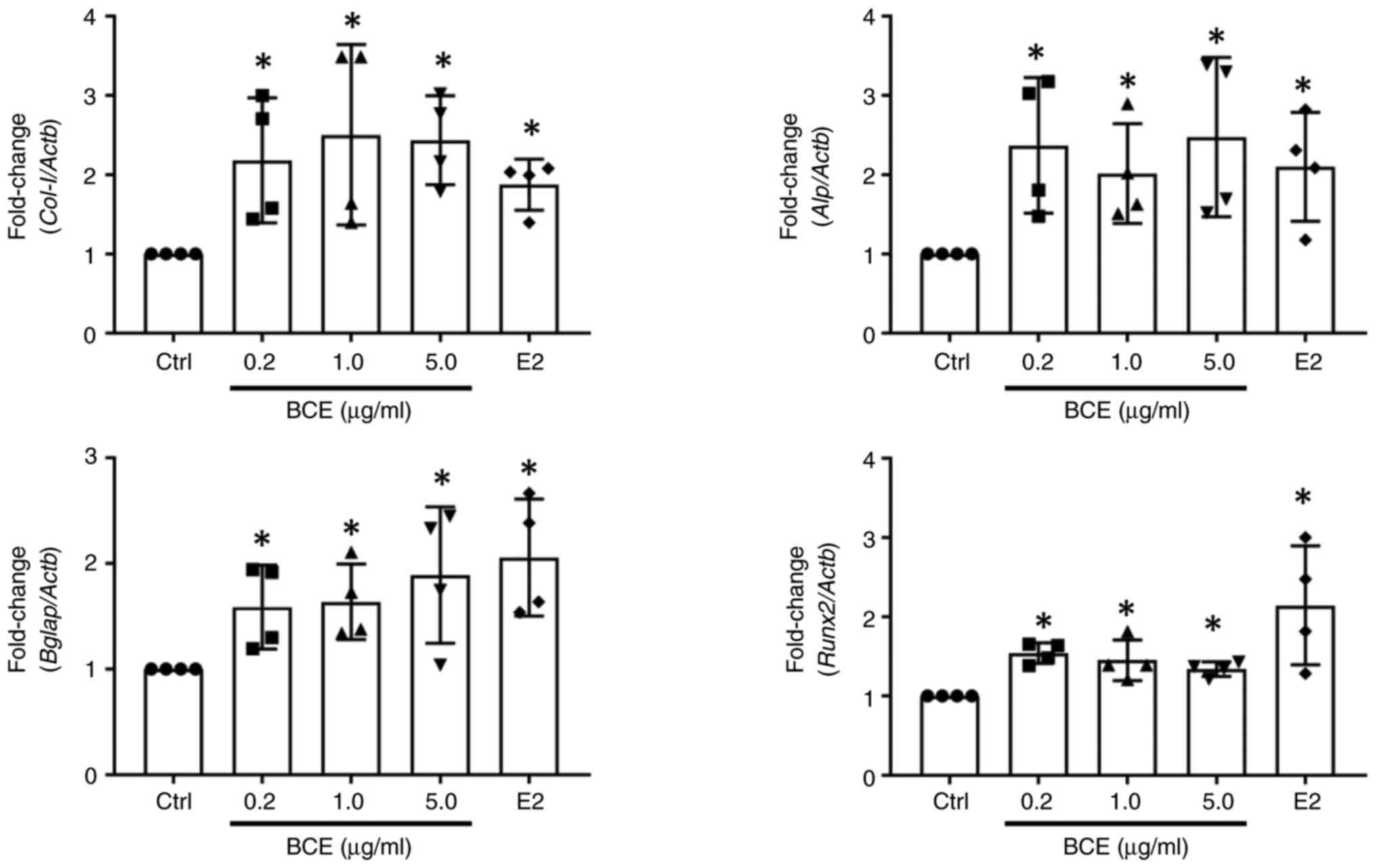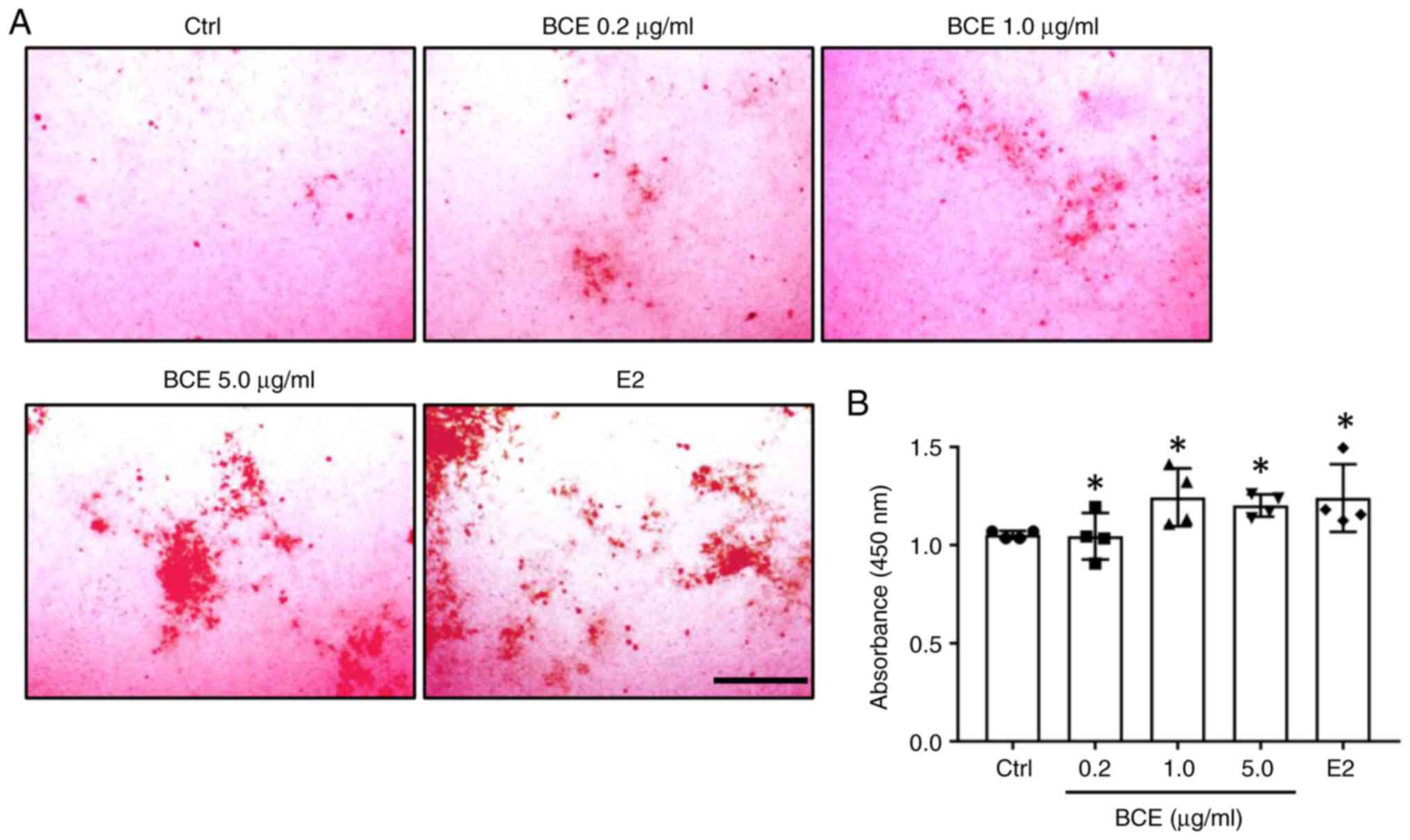|
1
|
Golovinskaia O and Wang CK: Review of
functional and pharmacological activities of berries. Molecules.
26(3904)2021.PubMed/NCBI View Article : Google Scholar
|
|
2
|
Cortez RE and Gonzalez de Mejia E:
Blackcurrants (Ribes nigrum): A review on chemistry,
processing, and health benefits. J Food Sci. 84:2387–2401.
2019.PubMed/NCBI View Article : Google Scholar
|
|
3
|
Gopalan A, Reuben SC, Ahmed S, Darvesh AS,
Hohmann J and Bishayee A: The health benefits of blackcurrants.
Food Funct. 3:795–809. 2012.PubMed/NCBI View Article : Google Scholar
|
|
4
|
Lephart ED: Phytoestrogens (resveratrol
and equol) for estrogen-deficient skin-controversies/misinformation
versus anti-aging in vitro and clinical evidence via
nutraceutical-cosmetics. Int J Mol Sci. 22(11218)2021.PubMed/NCBI View Article : Google Scholar
|
|
5
|
Nguyen M and Osipo C: Targeting breast
cancer stem cells using naturally occurring phytoestrogens. Int J
Mol Sci. 23(6813)2022.PubMed/NCBI View Article : Google Scholar
|
|
6
|
Jia M, Dahlman-Wright K and Gustafsson JA:
Estrogen receptor alpha and beta in health and disease. Best Pract
Res Clin Endocrinol Metab. 29:557–568. 2015.PubMed/NCBI View Article : Google Scholar
|
|
7
|
Lobo RA: Metabolic syndrome after
menopause and the role of hormones. Maturitas. 60:10–18.
2008.PubMed/NCBI View Article : Google Scholar
|
|
8
|
Prisby RD: Mechanical, hormonal and
metabolic influences on blood vessels, blood flow and bone. J
Endocrinol. 235:R77–R100. 2017.PubMed/NCBI View Article : Google Scholar
|
|
9
|
Nanashima N, Horie K and Maeda H:
Phytoestrogenic activity of blackcurrant anthocyanins is partially
mediated through estrogen receptor beta. Molecules.
23(74)2017.PubMed/NCBI View Article : Google Scholar
|
|
10
|
Nanashima N, Horie K, Tomisawa T, Chiba M,
Nakano M, Fujita T, Maeda H, Kitajima M, Takamagi S, Uchiyama D, et
al: Phytoestrogenic activity of blackcurrant (Ribes nigrum)
anthocyanins is mediated through estrogen receptor alpha. Mol Nutr
Food Res. 59:2419–2431. 2015.PubMed/NCBI View Article : Google Scholar
|
|
11
|
Horie K, Nanashima N and Maeda H:
Phytoestrogenic effects of blackcurrant anthocyanins increased
endothelial nitric oxide synthase (eNOS) expression in human
endothelial cells and ovariectomized rats. Molecules.
24(1259)2019.PubMed/NCBI View Article : Google Scholar
|
|
12
|
Nanashima N and Horie K: Blackcurrant
extract with phytoestrogen activity alleviates hair loss in
ovariectomized rats. Molecules. 24(1272)2019.PubMed/NCBI View Article : Google Scholar
|
|
13
|
Nanashima N, Horie K, Maeda H, Tomisawa T,
Kitajima M and Nakamura T: Blackcurrant anthocyanins increase the
levels of collagen, elastin, and hyaluronic acid in human skin
fibroblasts and ovariectomized rats. Nutrients.
10(495)2018.PubMed/NCBI View Article : Google Scholar
|
|
14
|
Nanashima N, Horie K, Yamanouchi K,
Tomisawa T, Kitajima M, Oey I and Maeda H: Blackcurrant (Ribes
nigrum) extract prevents dyslipidemia and hepatic steatosis in
ovariectomized rats. Nutrients. 12(1541)2020.PubMed/NCBI View Article : Google Scholar
|
|
15
|
Zhang Y, Liang J, Liu P, Wang Q, Liu L and
Zhao H: The RANK/RANKL/OPG system and tumor bone metastasis:
Potential mechanisms and therapeutic strategies. Front Endocrinol
(Lausanne). 13(1063815)2022.PubMed/NCBI View Article : Google Scholar
|
|
16
|
Cheng CH, Chen LR and Chen KH:
Osteoporosis due to hormone imbalance: An overview of the effects
of estrogen deficiency and glucocorticoid overuse on bone turnover.
Int J Mol Sci. 23(1376)2022.PubMed/NCBI View Article : Google Scholar
|
|
17
|
Tunheim EG, Skallevold HE and Rokaya D:
Role of hormones in bone remodeling in the craniofacial complex: A
review. J Oral Biol Craniofac Res. 13:210–217. 2023.PubMed/NCBI View Article : Google Scholar
|
|
18
|
Okagu IU, Aham EC, Ezeorba TPC, Ndefo JC,
Aguchem RN and Udenigwe CC: Osteo-modulatory dietary proteins and
peptides: A concise review. J Food Biochem.
46(e14365)2022.PubMed/NCBI View Article : Google Scholar
|
|
19
|
Sfeir JG, Drake MT, Khosla S and Farr JN:
Skeletal aging. Mayo Clin Proc. 97:1194–1208. 2022.PubMed/NCBI View Article : Google Scholar
|
|
20
|
Zhou T, Gai Z, Gao X and Li L: The
potential mechanism of exercise combined with natural extracts to
prevent and treat postmenopausal osteoporosis. J Healthc Eng.
2021(2852661)2021.PubMed/NCBI View Article : Google Scholar
|
|
21
|
Harahap IA and Suliburska J: Probiotics
and isoflavones as a promising therapeutic for calcium status and
bone health: A narrative review. Foods. 10(2685)2021.PubMed/NCBI View Article : Google Scholar
|
|
22
|
Mayo B, Vázquez L and Flórez AB: Equol: A
bacterial metabolite from the daidzein isoflavone and its presumed
beneficial health effects. Nutrients. 11(2231)2019.PubMed/NCBI View Article : Google Scholar
|
|
23
|
Sakaki J, Melough M, Lee SG, Kalinowski J,
Koo SI, Lee SK and Chun OK: Blackcurrant supplementation improves
trabecular bone mass in young but not aged mice. Nutrients.
10(1671)2018.PubMed/NCBI View Article : Google Scholar
|
|
24
|
Zheng X, Mun S, Lee SG, Vance TM, Hubert
P, Koo SI, Lee SK and Chun OK: Anthocyanin-rich blackcurrant
extract attenuates ovariectomy-induced bone loss in mice. J Med
Food. 19:390–397. 2016.PubMed/NCBI View Article : Google Scholar
|
|
25
|
Nosal BM, Sakaki JR, Macdonald Z, Mahoney
K, Kim K, Madore M, Thornton S, Tran TDB, Weinstock G, Lee ECH and
Chun O: Blackcurrants reduce the risk of postmenopausal
osteoporosis: A pilot double-blind, randomized, placebo-controlled
clinical trial. Nutrients. 14(4971)2022.PubMed/NCBI View Article : Google Scholar
|
|
26
|
Oursler MJ, Landers JP, Riggs BL and
Spelsberg TC: Oestrogen effects on osteoblasts and osteoclasts. Ann
Med. 25:361–371. 1993.PubMed/NCBI View Article : Google Scholar
|
|
27
|
Moriwaki S, Suzuki K, Muramatsu M, Nomura
A, Inoue F, Into T, Yoshiko Y and Niida S: Delphinidin, one of the
major anthocyanidins, prevents bone loss through the inhibition of
excessive osteoclastogenesis in osteoporosis model mice. PLoS One.
9(e97177)2014.PubMed/NCBI View Article : Google Scholar
|
|
28
|
Ahmad Hairi H, Jamal JA, Aladdin NA,
Husain K, Mohd Sofi NS, Mohamed N, Mohamed IN and Shuid AN:
Demethylbelamcandaquinone B (Dmcq B) is the active compound of
marantodes pumilum var. Alata (Blume) kuntze with osteoanabolic
activities. Molecules. 23(1686)2018.PubMed/NCBI View Article : Google Scholar
|
|
29
|
Kim M, Lim J, Lee JH, Lee KM, Kim S, Park
KW, Nho CW and Cho YS: Understanding the functional role of
genistein in the bone differentiation in mouse osteoblastic cell
line MC3T3-E1 by RNA-seq analysis. Sci Rep. 8(3257)2018.PubMed/NCBI View Article : Google Scholar
|
|
30
|
Luo D, Kang L, Ma Y, Chen H, Kuang H,
Huang Q, He M and Peng W: Effects and mechanisms of
8-prenylnaringenin on osteoblast MC3T3-E1 and osteoclast-like cells
RAW264.7. Food Sci Nutr. 2:341–350. 2014.PubMed/NCBI View Article : Google Scholar
|
|
31
|
Jiang X, Chen W, Shen F, Xiao W, Guo H, Su
H, Xiu J and Sun W: Pinoresinol promotes MC3T3-E1 cell
proliferation and differentiation via the cyclic AMP/protein kinase
A signaling pathway. Mol Med Rep. 20:2143–2150. 2019.PubMed/NCBI View Article : Google Scholar
|
|
32
|
Czekanska EM, Stoddart MJ, Richards RG and
Hayes JS: In search of an osteoblast cell model for in vitro
research. Eur Cell Mater. 24:1–17. 2012.PubMed/NCBI View Article : Google Scholar
|
|
33
|
Mao W, Huang G, Chen H, Xu L, Qin S and Li
A: Research progress of the role of anthocyanins on bone
regeneration. Front Pharmacol. 12(773660)2021.PubMed/NCBI View Article : Google Scholar
|
|
34
|
Kim H, Tabata A, Tomoyasu T, Ueno T,
Uchiyama S, Yuasa K, Tsuji A and Nagamune H: Estrogen stimuli
promote osteoblastic differentiation via the subtilisin-like
proprotein convertase PACE4 in MC3T3-E1 cells. J Bone Miner Metab.
33:30–39. 2015.PubMed/NCBI View Article : Google Scholar
|
|
35
|
Cai W, Sun B, Song C, Liu F, Wu Z and Liu
Z: Resveratrol induces proliferation and differentiation of mouse
pre-osteoblast MC3T3-E1 by promoting autophagy. BMC Complement Med
Ther. 23(121)2023.PubMed/NCBI View Article : Google Scholar
|
|
36
|
Norikura T, Sasaki Y, Kojima-Yuasa A and
Kon A: Glyoxylic Acid, an α-keto acid metabolite derived from
glycine, promotes myogenesis in C2C12 cells. Nutrients.
15(1763)2023.PubMed/NCBI View Article : Google Scholar
|
|
37
|
Livak KJ and Schmittgen TD: Analysis of
relative gene expression data using real-time quantitative PCR and
the 2(-Delta Delta C(T)) method. Methods. 25:402–408.
2001.PubMed/NCBI View Article : Google Scholar
|
|
38
|
Xiao HH, Fung CY, Mok SK, Wong KC, Ho MX,
Wang XL, Yao XS and Wong MS: Flavonoids from Herba epimedii
selectively activate estrogen receptor alpha (ERα) and stimulate
ER-dependent osteoblastic functions in UMR-106 cells. J Steroid
Biochem Mol Biol. 143:141–151. 2014.PubMed/NCBI View Article : Google Scholar
|
|
39
|
Hu B, Chen L, Chen Y, Zhang Z, Wang X and
Zhou B: Cyanidin-3-glucoside regulates osteoblast differentiation
via the ERK1/2 signaling pathway. ACS Omega. 6:4759–4766.
2021.PubMed/NCBI View Article : Google Scholar
|
|
40
|
Park KH, Gu DR, So HS, Kim KJ and Lee SH:
Dual role of cyanidin-3-glucoside on the differentiation of bone
cells. J Dent Res. 94:1676–1683. 2015.PubMed/NCBI View Article : Google Scholar
|
|
41
|
Matsushita Y, Ono W and Ono N: Growth
plate skeletal stem cells and their transition from cartilage to
bone. Bone. 136(115359)2020.PubMed/NCBI View Article : Google Scholar
|
|
42
|
Fusaro M, Crepaldi G, Maggi S, D'Angelo A,
Calo L, Miozzo D, Fornasieri A and Gallieni M: Bleeding, vertebral
fractures and vascular calcifications in patients treated with
warfarin: Hope for lower risks with alternative therapies. Curr
Vasc Pharmacol. 9:763–769. 2011.PubMed/NCBI View Article : Google Scholar
|
|
43
|
Shao X, Cao X, Song G, Zhao Y and Shi B:
Metformin rescues the MG63 osteoblasts against the effect of high
glucose on proliferation. J Diabetes Res.
2014(453940)2014.PubMed/NCBI View Article : Google Scholar
|
|
44
|
Setchell KDR and Lydeking-Olsen E: Dietary
phytoestrogens and their effect on bone: Evidence from in vitro and
in vivo, human observational, and dietary intervention studies. Am
J Clin Nutr. 78 (3 Suppl):593S–609S. 2003.PubMed/NCBI View Article : Google Scholar
|
|
45
|
Torre E: Molecular signaling mechanisms
behind polyphenol-induced bone anabolism. Phytochem Rev.
16:1183–1226. 2017.PubMed/NCBI View Article : Google Scholar
|
|
46
|
Arnal JF, Lenfant F, Metivier R, Flouriot
G, Henrion D, Adlanmerini M, Fontaine C, Gourdy P, Chambon P,
Katzenellenbogen B and Katzenellenbogen J: Membrane and nuclear
estrogen receptor alpha actions: From tissue specificity to medical
implications. Physiol Rev. 97:1045–1087. 2017.PubMed/NCBI View Article : Google Scholar
|
|
47
|
Canivenc-Lavier MC and Bennetau-Pelissero
C: Phytoestrogens and health effects. Nutrients.
15(317)2023.PubMed/NCBI View Article : Google Scholar
|
|
48
|
Dinger J, Bardenheuer K and Heinemann K:
Drospirenone plus estradiol and the risk of serious cardiovascular
events in postmenopausal women. Climacteric. 19:349–356.
2016.PubMed/NCBI View Article : Google Scholar
|
|
49
|
Dinger J, Do Minh T and Heinemann K:
Impact of estrogen type on cardiovascular safety of combined oral
contraceptives. Contraception. 94:328–339. 2016.PubMed/NCBI View Article : Google Scholar
|















